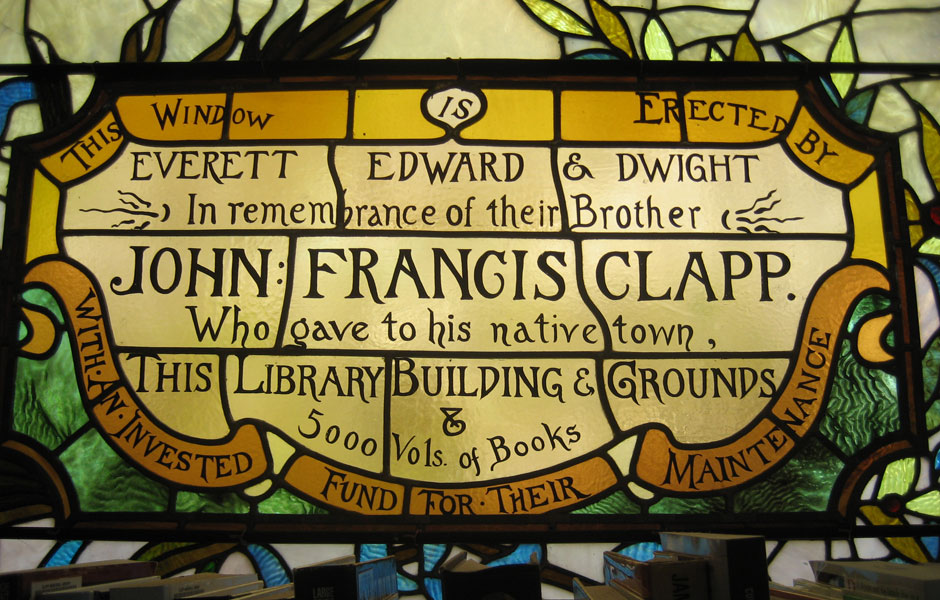History of the Library
The Clapp Memorial Library was built as the result of a bequest from Belchertown native John Francis Clapp. Clapp’s father, James Harvey Clapp, moved to Belchertown from Northampton in 1812, and was prominent in public affairs for over sixty years, serving as a selectman, County Commissioner, and three-term representative to the State Legislature. He was one of the proprietors of the Boston and Albany stage line and also owned a Belchertown hotel. John Francis, the eldest of 8 children, was born in 1818. A studious young man, he set off for New York City at age 16, where he achieved wealth and success as a partner in the firm of Simpson, Clapp and Company. Brothers Everett, Dwight, and Edward Lyman followed their older brother to New York, and like him, became merchants. They continued to maintain residences on South Main Street near the library, returning with their families during the summer months.
John Francis is credited with saying he regretted never having enough to read as a boy. Hoping to spare other Belchertown children this fate, he left a bequest of $40,000 in the hands of his brothers, with the provision that it be used for the construction of a library and for the purchase of its contents. Clapp, who died in 1882, had stipulated that work on the project be completed within five years. His bequest, held in trust by his brothers and sensibly invested, grew to $46,000. On June 30, 1887, the Clapp Memorial Library building was dedicated. In an opening address, Dwight Clapp reminded his listeners to “do what little we can in our day to make life in this old hill town of New England richer and broader, higher and nobler, sweeter and purer, to generations which come after us.”
The Library building was designed by New York architect H.F. Kilburn in the Romanesque revival style that had been made popular in the 1870s by Henry Hobson Richardson. Built in the form of a Latin cross, the structure features an eighty-foot-high tower that rises from the intersection of the transepts and nave.
The asymmetrically placed apse and the arched entrance, surmounted by three windows enclosed in barreled arches, are all in keeping with the style.
The interior of the building is dominated by two stained glass windows, thought to have been fabricated by H.E. Hartwell, a New York decorator and designer who was also responsible for the interior decoration of the Library.
At the south end of the building is a window dedicated to the memory of John Francis Clapp, given by his brothers Everett, Edward, and Dwight P. Clapp. The subject of this window is literature, with the figure symbolizing thought and repose.
The north window was presented by Susan Bridgman, one of the original library trustees, in memory of her husband Calvin Bridgman. The figure in this window is Saint Cecilia, patroness of music. She is holding a viol, the favorite instrument of Mr. Bridgman.
The builders, Bartlett Brothers of Whately, MA, used local materials as much as possible in the construction of the Library. While the plate glass windows are French, and the red tiles of the roof came from Philadelphia, the stonework all originated in Massachusetts. The roughly cut exterior walls—characteristic of the Richardson style—were made of Longmeadow brownstone, while the brick trim was carted from Holyoke. Even the stained glass windows, which evoke the rich tones of Venetian glass, were crafted from sand and silica mined in western Massachusetts. The interior woodwork is of ash, stained an antique oak shade and highly polished.
The library building was designed to include a stage, a reading room, and the library proper, with several smaller rooms to the side. Clapp particularly wanted space for lectures, concerts and other entertainments. Lydia A. Barton, the first librarian, opened the Library doors on September 1, 1887 and served until her death in 1914. The Library building is not owned or maintained by the Town, but is owned by the Trustees of the Library.



The Story of our Steinway
Our Steinway “Centennial” Concert Grand piano was completed in January 1877. The instrument was one of 424 manufactured by Steinway to honor the country’s centennial celebration. Originally sold to Mr. William H. Reers on January 16, 1877, the piano was bought back by Steinway & Sons about ten years later. It was resold on June 3, 1887 for $500 to Library Trustees Everett Clapp and Dwight Clapp with instructions that the piano be shipped to the Clapp Memorial Library.
For decades, the piano sat on the stage at the Library where children would perform their first recitals using the instrument. In the early 1990s, the piano was moved off the stage to provide space for a dedicated children’s area. Not long after, it became clear that the Library did not have sufficient space to house the grand piano.
Fortunately, the community stepped up to ensure that the piano remained in Belchertown. The Library Trustees formed an agreement with the Belchertown United Church of Christ to house the instrument. On December 12, 1996, after 110 years at the Clapp Memorial Library, the piano moved across the common to the the Church where it resides to this day.
Nearly 30 years later, our piano was showing its age and was no longer in playable condition. Thanks to the Community Preservation Committee and the residents of Belchertown, the Trustees of the Clapp Memorial Library received a CPA grant to fund a majority of the piano’s restoration. In the summer of 2024, Jim Mackie of Mackie Piano Restoration completed the project at his workshop in Hampden, Massachusetts. Now, the piano is back in Belchertown and a feature of library concerts.
